Transforming a modest area into a vibrant retreat starts with creative vision and thoughtful planning. Even the coziest balconies or patios can bloom into inviting escapes when you blend smart layouts with nature’s charm. The secret? Let your home’s architecture guide your choices while infusing personal touches that spark joy.
Design plays a pivotal role in maximizing every inch. Focus on color harmony and plant pairings that thrive in your climate. For instance, pairing cascading vines with compact perennials adds depth without clutter. Explore flower garden ideas like cottage-inspired arrangements or sleek succulent displays to match your taste.
Balance beauty and practicality by selecting low-maintenance varieties that suit your routine. A mix of textures—soft foliage against structured pots—creates visual interest. Remember, your sanctuary should feel effortless, not overwhelming.
Whether you crave serene Zen corners or lively butterfly havens, each choice reflects your story. With careful curation, even the tiniest plot becomes a place to unwind, entertain, and reconnect with nature’s rhythm.
Inspiring Outdoor Design Ideas for a Floral Retreat
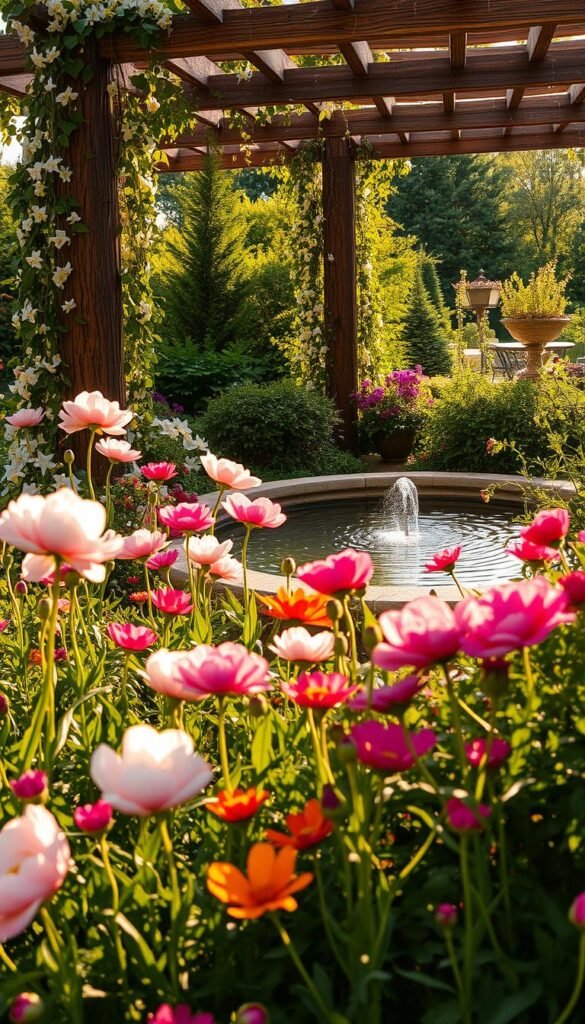
Unused corners of your property hold surprising potential. Take that narrow side area collecting dust – with gravel paths and a $90-$200 ceramic jar centerpiece, it becomes a cozy nook buzzing with life. Strategic design turns limitations into opportunities, blending textures and heights for depth.
Borders matter. Tumbled Cherokee stone (4″ x 12″) frames planting beds while adding rustic contrast. Pair it with creeping fig vines softening walls – their tiny leaves create living tapestries over seasons. Vertical layers free up ground space, perfect for petite plots.
| Element | Purpose | Cost Range |
|---|---|---|
| Decorative Jars | Focal points | $90-$200 |
| Cherokee Stone | Border definition | $2-$5/sq.ft |
| Liriope ‘Big Blue’ | Color contrast | $8-$12/plant |
Play with blooms that complement each other. Purple liriope spikes pop against white impatiens, while silvery Artemisia adds subtle shimmer. This mix thrives in partial sun, needing minimal care once established.
For more ways to enhance your gardening aesthetic, focus on affordable upgrades. A single striking pot or reclaimed trellis can redefine your entire look without overhauling the budget.
Understanding Garden Aesthetic Principles
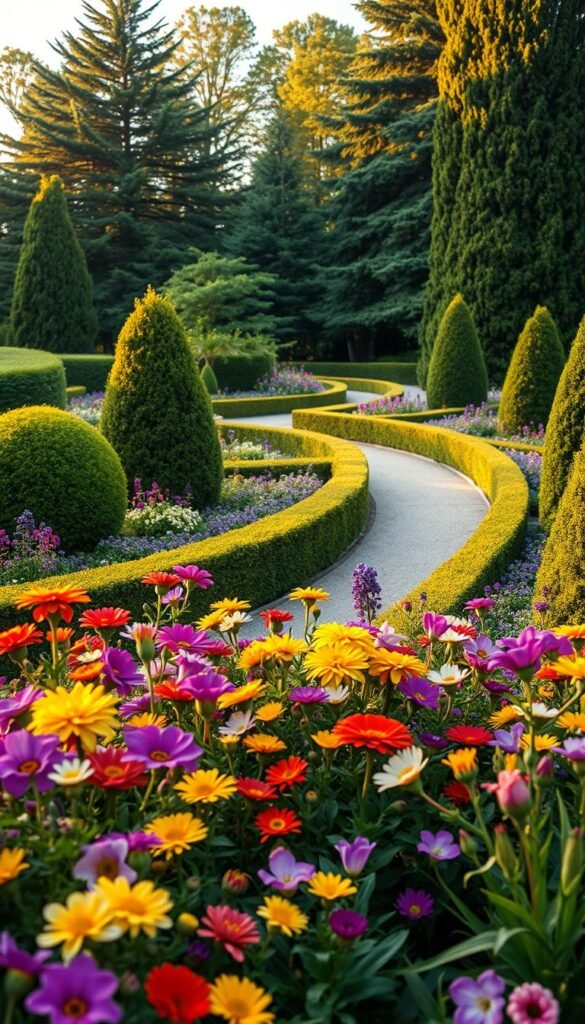
Crafting a stunning green space begins with mastering core design rules. Balance is everything—pair bold colors with soft textures, or structured shrubs with flowing grasses. Your site’s natural conditions dictate what thrives, so start by observing sunlight patterns and soil quality.
“A garden should feel inevitable, not imposed.”
| Principle | Role | Example |
|---|---|---|
| Color Harmony | Unifies spaces | Purple salvia + yellow coreopsis |
| Texture Layers | Adds depth | Feathery ferns + glossy boxwood |
| Structural Repetition | Creates rhythm | Repeating ornamental grasses |
Modern approaches favor simplicity. Think sculptural agave plants in gravel beds or symmetrical lavender rows. Less clutter means more impact—each element serves a purpose.
Color theory transforms moods. Warm reds energize seating areas, while cool blues soothe pathways. Pair velvety lamb’s ear with spiky yucca for tactile contrast that invites touch.
Remember: Great design works with nature, not against it. Choose plants that love your local climate, and watch your vision flourish effortlessly.
Flower Garden Aesthetic: Styling Your Outdoor Space with Grace
Blending beauty with purpose defines today’s most captivating gardens. Two standout trends—romantic edible layouts and modern meadows—let you merge visual charm with ecological mindfulness. Both approaches balance structure and spontaneity, perfect for creating spaces that feel intentional yet relaxed.
Romantic edible gardens reimagine classic cottage-inspired layouts by pairing hydrangeas and roses with blueberries or rosemary. Imagine plucking strawberries beside fragrant climbing roses—a feast for the senses and the table. This trend works beautifully in cottagecore-inspired designs, where practicality meets whimsy.
Meanwhile, modern meadows thrive on strategic simplicity:
- Ornamental grasses like switchgrass form airy backdrops
- Long-blooming perennials (think coneflowers or catmint) add pops of color
- Matrix planting creates depth through layered textures
This approach supports pollinators while minimizing upkeep. For summer-long impact, combine early bloomers like salvia with late-season stars such as asters. The result? A dynamic display that evolves daily.
Remember: Graceful styling means letting each plant shine. Use vertical specimens like foxgloves to draw the eye upward, then ground them with low-growing thyme or sedum. Your space becomes a living tapestry—both artful and alive with purpose.
Integrating Water Features for a Calming Outdoor Oasis
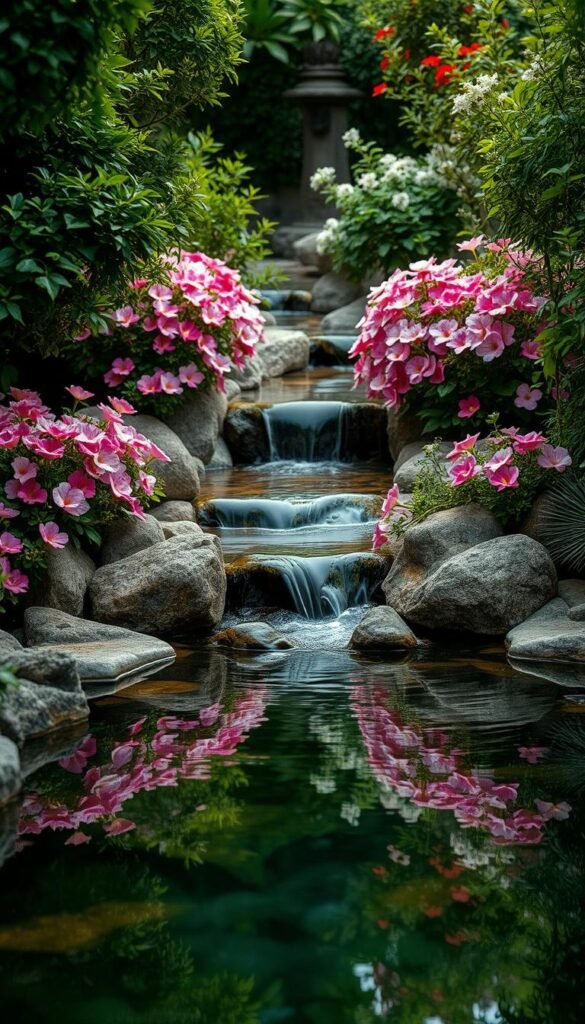
Adding movement to your landscape creates instant serenity. A bubbling fountain or miniature pond transforms ordinary areas into peaceful retreats, masking urban noise with nature’s rhythm. Even compact setups—like a glazed pot on a concrete base—deliver big impact without demanding square footage.
Selecting the Ideal Water Element
Match your water feature to your lifestyle and space. For tight areas, consider tabletop fountains or pre-fabricated concrete ponds (4′ diameter or smaller). These DIY-friendly options use pumps from local nurseries and pair beautifully with container gardening setups. Prioritize materials that withstand weather, like ceramic or fiberglass.
Maintenance and Placement Tips
Position features where you’ll enjoy them most—near seating areas or visible from windows. Ensure electrical access for pumps, or opt for solar-powered models. For low upkeep, add water-cleaning tablets monthly and trim nearby plants to prevent debris buildup.
Pair water elements with drought-tolerant succulents or ornamental grasses. This combo creates zen-like harmony while reducing watering needs. Use concrete pavers as stable bases to keep installations level through seasonal changes.
Creative Container and Raised Garden Bed Solutions
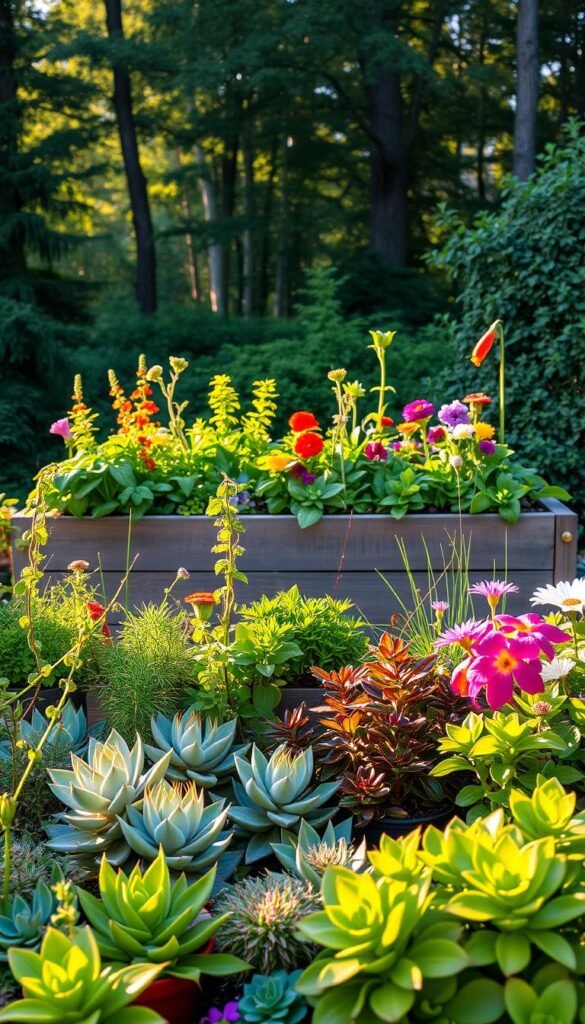
Limited square footage doesn’t mean sacrificing lush greenery. Through smart design choices, you can cultivate thriving plants in urban settings or awkward corners. The key lies in choosing systems that work with your environment rather than against it.
Maximizing Small Spaces with Raised Beds
Elevated planters solve multiple challenges at once. Cedar beds naturally resist rot while blending seamlessly into rustic or modern designs. Their 12-18″ height reduces bending strain and keeps pests at bay – perfect for growing herbs or cherry tomatoes.
| Element | Best Use | Benefits |
|---|---|---|
| Cedar Beds | Vegetable gardens | Natural durability, pest resistance |
| Steel Planters | Modern spaces | Sleek lines, modular arrangements |
| Vertical Containers | Privacy screens | Space efficiency, visual height |
Group three to five containers in staggered heights to create instant focal points. Try pairing a 24″ olive tree planter with cascading strawberry pots. This approach defines garden zones on concrete patios or rooftop decks.
For renters or condo dwellers, mobile solutions shine. Lightweight fiberglass troughs let you rearrange layouts seasonally. Add casters to larger beds for ultimate flexibility in tight spaces.
Remember: Your plants thrive when roots have room to grow. Choose containers at least 12″ deep for most vegetables. Mix ornamental grasses with edible blooms like nasturtiums to merge beauty and function.
Embracing Natural Elements: Plants, Perennials, Trees, and Shrubs
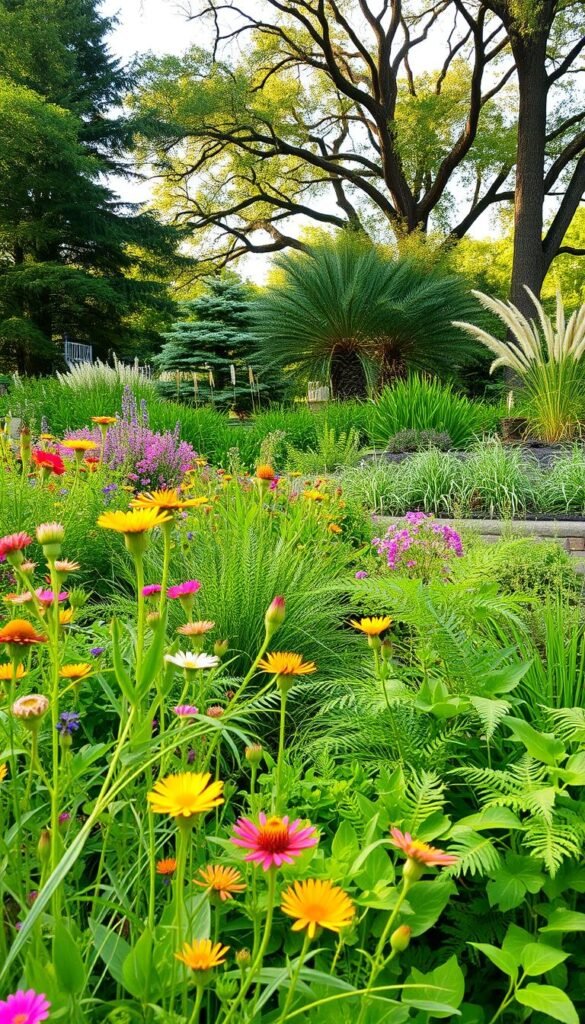
Creating a landscape that feels like an extension of nature begins with choosing the right elements. Native species form the backbone of resilient designs, offering beauty that thrives with minimal fuss. Let’s explore how to blend these organic components into cohesive, living art.
Achieving Balance with Native Flora
Start by selecting trees that anchor your space. Dogwoods dazzle with spring blooms, while Serviceberries deliver autumn berries for birds. Redbuds add striking purple-pink flowers early in the season. These trees create vertical interest and support local wildlife.
Shrubs bridge the gap between towering canopies and ground-level plants. Inkberry holly maintains glossy leaves year-round, and Oakleaf hydrangea offers bold summer flowers. Both thrive in varied light conditions, making them versatile choices.
| Plant Type | Key Benefits | Seasonal Interest |
|---|---|---|
| Dogwood | Wildlife support | Spring blooms |
| Inkberry Holly | Evergreen foliage | Winter berries |
| Ornamental Grasses | Low maintenance | Year-round texture |
For ground layers, combine perennials like Salvia and Yarrow. Their drought tolerance reduces watering needs. Group them in odd-numbered clusters for natural appeal—this mimics how they grow in wild meadows.
Want to deepen your approach? Explore signature landscaping techniques that prioritize ecological harmony. Remember: Native cultivars offer upgraded traits without losing environmental benefits. A compact Redbud variety might fit small yards better while still feeding pollinators.
Space plants according to their mature size. This prevents overcrowding and lets each specimen shine. Over time, your shrubs and trees will form a layered sanctuary that changes gracefully with the seasons.
Layering Color and Texture for Visual Impact
A captivating landscape begins with strategic layering that engages both eyes and emotions. By thoughtfully combining color gradients and tactile contrasts, you craft moments of surprise and harmony in every glance.
Choosing a Dynamic Color Palette
Bold hues like fiery orange daylilies or deep purple salvias demand attention. Balance them with crisp white phlox or silvery Artemisia to prevent visual overload. Cool-toned foliage creates calming backdrops, letting vibrant blooms pop.
Mixing Textures with Foliage and Blooms
Pair feathery maiden grass with velvety lamb’s ear for tactile drama. Spiky yucca leaves contrast beautifully against round hydrangea clusters. Repeat textures across beds to build rhythm while keeping compositions cohesive.
Modern spaces thrive on restraint. Try a monochromatic palette of chartreuse hostas and emerald ferns, accented by seasonal red twig dogwood stems. This approach ensures year-round impact without constant replanting.






